
34 minute read
SÍ TU PUEDES! There’s no
¡SÍ TU PUEDES!
IT starts with mere sounds, which become words, which turn into sentences that convey meaning. Learning to speak and to understand what others say is nothing short of an everyday miracle. We learn our mother tongue effortlessly, as children. But as older adults, trying to learn a second language can seem a daunting task. Now that I am retired and I love traveling throughout Mexico, I am gradually learning Spanish.
Advertisement
My wife, Kay, and I manage to fly there about twice a year, but neither of us speaks much Spanish. We get by with a little book of Spanish phrases that keep us from starving at restaurants, and we rely a lot on gesturing.
Our appreciation of Mexico’s culture and people is seriously limited by our inability to speak Spanish. Not to mention how stressful it can be getting on the right bus when no one in the bus station speaks English or guessing what the hotel clerk in the small town of Zitácuaro is telling you when he gives you your key. Is he saying, “Watch out for scorpions,” or “a free breakfast will be served at 6 a.m.”?
To improve our Spanish, Kay and I spent two weeks in an immersion language program in Cuernavaca, a city about an hour south of Mexico City. Although I had a semester of college Spanish 50 years ago, Kay had never studied any foreign language. Despite our lack of formal language education, we both learned a lot—more than we thought
possible. It wasn’t easy, but if we wanted easy, we’d have opted for a Caribbean cruise. I m m e r s i o n l a n g u a g e programs can be challenging. I n m o s t i m m e r s i o n programs, only the foreign language is spoken from the moment class starts until the end of the day. These programs require a commitment to learn as well as realistic expectations. Contrar y to what many people think, a few weeks of immersive study won’t make you fluent. The School of Language Studies of the U.S. Department of State has a long history of teaching 65 different languages to the diplomatic corps. According to their research, on average, adult learners can expect to become proficient in Spanish in about 6 months. That’s six months of classes for four hours a day, plus several more hours each day studying. You don’t need to go to Mexico or Spain to learn Spanish. In the Seattle area there are plenty of options for older adults who want to improve their Spanish or other foreign language skills—everything from community college classes to private lessons, in person or on the Internet. Because almost all language education is geared toward young adults or school-age kids, you need to find a teacher who understands that older adults learn differently than youths.
The idea of studying how older adults learn a second language is relatively new. Danya Ramirez-Gomez, Ph.D., has been researching the process and has written a book about it, Language Teaching and the Older Adult: The Significance of Experience. In a recent interview, she explained that age is no obstacle for learning a second language. “The idea that just because you’re over 60 that you can’t learn a second language isn’t right. It’s not too late,” she said.
Not only is it not too late, but it might be just in time. YES YOU CAN! There’s No Better Time to Learn a Second Language BY JACK WAX
(CONTINUED ON NEXT PAGE)
When older adults make the effort to learn a new language, we give our brains a boost. We start rethinking how we learn, and quickly develop strategies to make the best use of our cognitive skills, regardless of any normal age-related declines. “The process helps you cope better with other cognitive challenges,” said RamirezGomez.
Ramirez-Gomez pointed out that most scientists accept the idea of a critical period—a time when learning a language come naturally, without effort. It ends somewhere between the ages of five and 12. But just because that window of time is long past, doesn’t mean that the window is shut. “After the critical period, there are tons of
different ways we learn,” she said.
With strong motivation, older people can become conversant in a second language, said Ramirez-Gomez. The key to successful language learning is accommodating the differences, not necessarily negative ones, between older and younger students. A positive attitude is the first and foremost requirement—not just on the part of the learner, but the teacher, as well.
The stereotype of older adults being less able to learn can become a self-fulfilling prophesy. “We need to take seriously the idea that learning should be learner centered,” she said.
According to Ramirez-Gomez, foreign language learning is far more than a leisure activity. The process contributes to our cognitive, emotional and social well-being. Additionally, it opens our world to the possibilities of rewarding international travel and meaningful relationships with people from other cultures. Jack Wax is chair of the Advisory Council of the Osher@ Mizzou Lifelong Learning Institute in Columbia, Missouri. He enjoys freelancing because each article is a chance to learn about someone or something new.
Learning a Second Language —Tips for Older Adults
Based on Becoming Fluent: How Cognitive Science Can Help Adults Learn a Foreign Language, by Richard Roberts and Roger Kreuz
• Stay motivated. Focus on the learning process, not the desired result. • Make a habit out of study. Set aside time every day to learn. • Avoid educational settings that feature rapid-fire questionand-answer practice. Older adults have slower reaction times and take longer to process information than younger learners. • Avoid relying on rote memory as your main learning technique. Instead, use your vast store of experiences by integrating new concepts into already existing ones. • Build on your strengths. Unlike children absorbing language, older adults can be intentional and develop learning strategies suited to their learning style and needs. • Listen and try to speak in a variety of settings with a variety of different people. • Don’t worry about learning thousands of new words. Several hundred terms will allow you to communicate. • Avoid cognitive overload. Study a bit, relax a bit, go back to studying more. • Use all your modalities for learning—reading, writing, speaking, listening.
PUGET SOUND
Live Like You Mean It Don’t Let Age Limit You

SUBSCRIBE TODAY! Go to 3rdActMag.com to place your order Now!
AGING WITH PRIDE GenPride serves LGBTQ Seniors 3rd Act Magazine publishes four times a year. Due to the coronavirus, there will be fewer copies available for pickup in the community. Don't miss an issue, subscribe today to receive your mailed copy.
SU MMER 20 19
A Whole New Place to Retire 3 Washington Towns Worth Considering Brain Power Join the Golden Age of Lifelong Learning In these turbulent times, 3rd Act is a positive voice for aging with confidence WINTE R 20 19 HOUSE SHARIN G An Option Wo rt h Considerin g TR AV EL St retch Yo ur Comfor t Zo ne NEW LE AS HES ON LIFE Lo ving Homes for Se nior Dogs Ha pp ines s Wh y We Get Happie r wi th Ag e Ar t Withou t Bo rder s e Subl im e Wo rk of Se at tl e Ar ti st Alfr ed o Ar re guin Change Pa rtin g wi th a Home Yo u Lo ve Mode rn Ma tc hmakin g It ’s Ne ve r To o La te to Date NO BAD BREA KS Bone Up on Os te oporosis FEAR AG IN G? Yo u’ re Not Alone TE CHNO LO GY WE LO VE It ’s Not Ro ck et Scienc e 50 Wa ys to Thri ve FO LL OW THESE SIMP LE TI PS AND FL OURISH AT EV ER Y AG E To gether Fore ve r HO W TO NA VIGA TE RETIREMENT WIT H YO UR SPOU SE Li fe as P oet ry Te ss Gallaghe r on Creativit y, Vitali ty , and Resilien ce
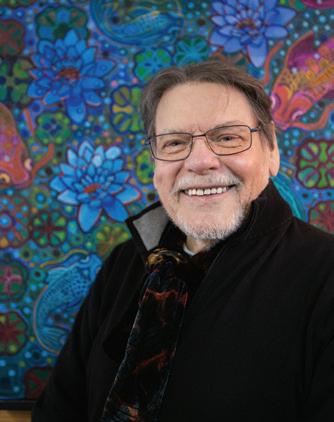

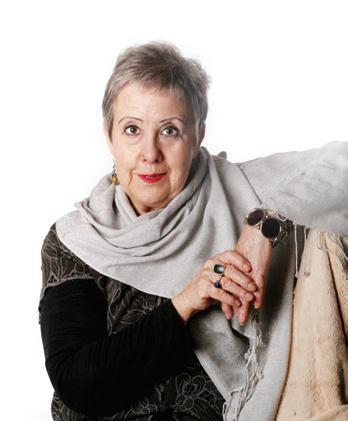

• Conscious Aging
THE OTHER BOOM Retirement Living Options Surge • Health & Wellness • Retirement Planning • Travel & Entertainment • Insights & Ideas
The Puget Sound skyline sports a now familiar ridge of construction cranes that reflects the region’s youthful tech boom and population growth. Look a little closer, though, and you’ll see a different kind of expansion underway—robust development of vibrant communities for mature adults. A handful of examples illustrate the point. Bellevue-based Aegis Living, which offers premium assisted-living and memory-care options, plans to double its number of communities by 2030, and currently has six Seattle projects either in the pipeline or under construction. This year, the company also breaks ground on a community in San Rafael, adding to an established California presence. SHAG (Sustainable Housing for Ageless Generations) depends on the federal tax credit program to operate 26 local independent-living communities, with plans to move beyond the Puget Sound area in the future, taking its focus on affordable retirement living to a national audience. With properties in eight states, family-owned Koelsch Communities is building a $93 million assisted-living and memory-care project in Belle Harbor, Bellevue, as well as other memory-care communities in both Kirkland and Puyallup.
A major development is going up north of Seattle where Quail Park of Lynnwood has 96 assisted-living apartments under construction along with 26 luxury, independent-living cottages.
No surprise, the need for additional and varied communities is, in part, driven by the Baby Boom. Born between 1946 and 1964, this generation is now retiring in droves with population intensity building for many years to come. Factor in that people are living longer, an increased demand for services is clear.
“There are tectonic shifts happening in senior housing with lots of players in the game, both for-profit and nonprofit,” says Kris Engskov, president of Aegis Living. “We’ll have more people over the age of 75 by 2025 than people under the age of 18. That’s never happened before.”
In addition to the need for more living spaces for more people, companies CUTTING-EDGE COMMUNITIES FOR OLDER ADULTS ARE SURGING IN OUR REGION BY CONNIE MCDOUGALL
are building now because they can, says Aaron Koelsch, president, and chief executive officer of Koelsch Communities. “During the recession, building construction came to a near standstill. They couldn’t find bank partners, and yet our country did not stop aging. Now we’re catching up to that pent-up demand. Financing is far more available, and it’s not expensive.”
Yet another driver of retirement construction is the money to be made, at least for the higher-end properties. “Yes, absolutely, if done right, or we wouldn’t be able to get financing,” Koelsch says. “There are rewards for the risk taken.”
According to the article “Winners and Losers as Oregon’s Population Ages” on the website OregonBusiness.com, investment profit on adult communities can beat out apartment or commercial buildings. “The companies investing in elder-care projects reap big profit margins. It continues, “With big profits, many private-equity firms and institutional investors are moving into senior housing. The sector is also attracting interest from abroad.”
That’s a reversal from the past, notes Beth Burnham Mace, chief economist at the Annapolis-based National Investment Center for Senior Housing and Care, also known as NIC. The nonprofit conducts research, offering valuable data and analytics for investors as well as to providers of housing and care.
“Twenty-five years ago, there wasn’t the comfort-level from investors that there is now,” she says. “Today, we have more transparency, more data, and investors are more knowledgeable about both the opportunities and the challenges of investing in this property type. They also see senior housing as more recession-proof, especially assisted living, due to its needbased services. If you’re an investor, you like that because it takes away some of the risk in economic cycles.”
The money tends to flow toward premium properties, and Mace would like to see affordable, middle-income communities share in the bounty. “Investors want good returns, of course, but I’m asking, can’t there
be a social responsibility aspect we can talk about?”
As the quantity of mature communities changes, so does the quality. We’ve come a long way from the old model of nursing homes, with the Boomer wave ushering in an age of innovation.
“They [Boomers] never accepted the status quo. They’re always looking for what’s new,” says Keri Pollock with Aging Wisdom, a consulting and care management practice for older adults and their families. “There are all kinds of alternatives now, from virtual villages to continuing care,” she says.
As an example of progressive change, Pollock points to an innovative eight-story LGBTQ retirement apartment building under construction on Seattle’s Capitol Hill, The Eldridge.
“The sad reality is, older LGBTQ folks may be stigmatized in some settings,” says Pollock. “This will be a welcoming and affirming place, the first of its kind in Washington State.”
Care for the environment is a birthright

of this generation. Earth Day began in 1970. It’s no wonder that adult communities also embrace those values. Last year, Aegis Living broke ground on a property along the Kirkland waterfront that’s billed as the “greenest senior living building in the world.” Kris Engskov with Aegis explains that the company continually gauges the desires of its customers and adapts to meet them. “Their expectations are very different from the last generation. People want experiences. It’s integrated into how they live.”
He adds that these communities must also appeal to the grown children of older adults. “In urban markets we’re seeing adult children bringing their parents closer to them, where they work, especially in Seattle and San Francisco, the tech hubs.”
And the kids favor amenities, engagement and innovation. Responding to that demand,


Photos clockwise from the top left: Rendering of outdoor patio at Bell Harbor, a Koelsch assisted-living and memorycare community under construction in Bellevue; waterfall at Aegis Living, Mercer Island; and rendering of Aegis Living's new Bellevue Overlake community, now under construction.
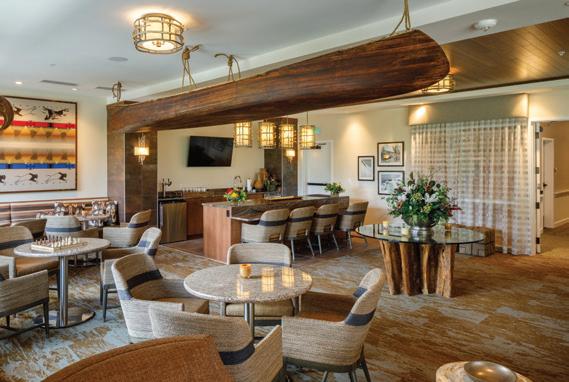
more and more communities are adopting a hotel model of service, complete with concierge.
“We call it living in place rather than aging in place,” says David Haack, executive vice president and chief marketing officer with Living Care Lifestyles, which operates Quail Park properties in Washington, California, Arizona, and Texas.
Always looking for new ways to engage, the company launches an educational experiment this spring called Quail Park U in which a small cohort follows a six-month curriculum that includes exercise and nutrition classes. Haack says, “If it’s popular, and I expect it will be, we’ll be introducing Quail Park U this year to our entire Lynnwood campus.”
Early on, his company embraced technology, including virtual reality (VR) sessions at the memory-care community of Quail Park, West Seattle. Research shows that VR can enrich the lives of people dealing with dementia. “People want to be recognized, not marginalized,” says Haack.
C u t t i n g - e d g e t e c h n o l o g i e s are an increasing feature of adult communities. Consider the new Koelsch assisted-living and memorycare project under construction in Belle Harbor, Bellevue. “The memorycare community is three stories rather
With attention to detail inside and out many new communities offer a variety of resortlike common areas. Left, the Keywaydin Sky Lounge at Aegis, Mercer Island. Right, a rendering of an outdoor patio at Koelsch's new Bellevue community.
than ground level,” Aaron Koelsch says. “To address safety and access, we’ve taken tech to another level. On a scale of 1-10, this is a 10. There are cameras, advanced calling and alarm systems, as well as other safety and security technologies.”
Jay Woolford, executive director of SHAG, says his organization’s most innovative effort is finding new, creative ways to provide affordable independent-living options within a lively community.
“We’re trying to help people who don’t have access to higher-end options, which is most people. We develop and produce housing in an efficient way, relying on federal tax credits,” Woolford says. “Our model also encourages diversity. We mirror the local population, with multiple cultures from different backgrounds. Our objective is to be part of the broader neighborhood, not an isolated island of seniors in a service desert.”
Also seeking new approaches to affordability, Care Partners Senior Living offers varied levels of care including independent living, assisted

living, and memory care. This locally owned and operated company has 13 properties in the Puget Sound area with additional communities being built this year.
Regional sales manager Susan Dale explains that they utilize resources in the community to expand what they can offer. “To enrich lives, we partner with senior centers, the YMCA, local schools and others. Ours is a unique model in the industry, aiming at the middle class who have worked hard all their lives.”
While these families typically have savings, a pension and a home, Care Partners works to make sure people don’t outlive their means. Dale says, “We’re dedicated to easing the stress on families. Our residents can spend down to Medicaid. We offer excellent care, comfort and community.”
Going forward, every bit of ingenuity from all stakeholders will be needed to successfully navigate this brave new world of living options for mature adults. “We’re taking care of that first wave now,” says Aegis’s Kris Engskov. “The next wave lands in 20 years. We are just getting started.”.
Connie McDougall is a former news reporter and current freelance writer of nonfiction and personal essays. A lifelong student and proud English major, she has pursued lessons in flying, scuba diving, tai chi, Spanish, meditation, hiking and, most recently, Zumba.
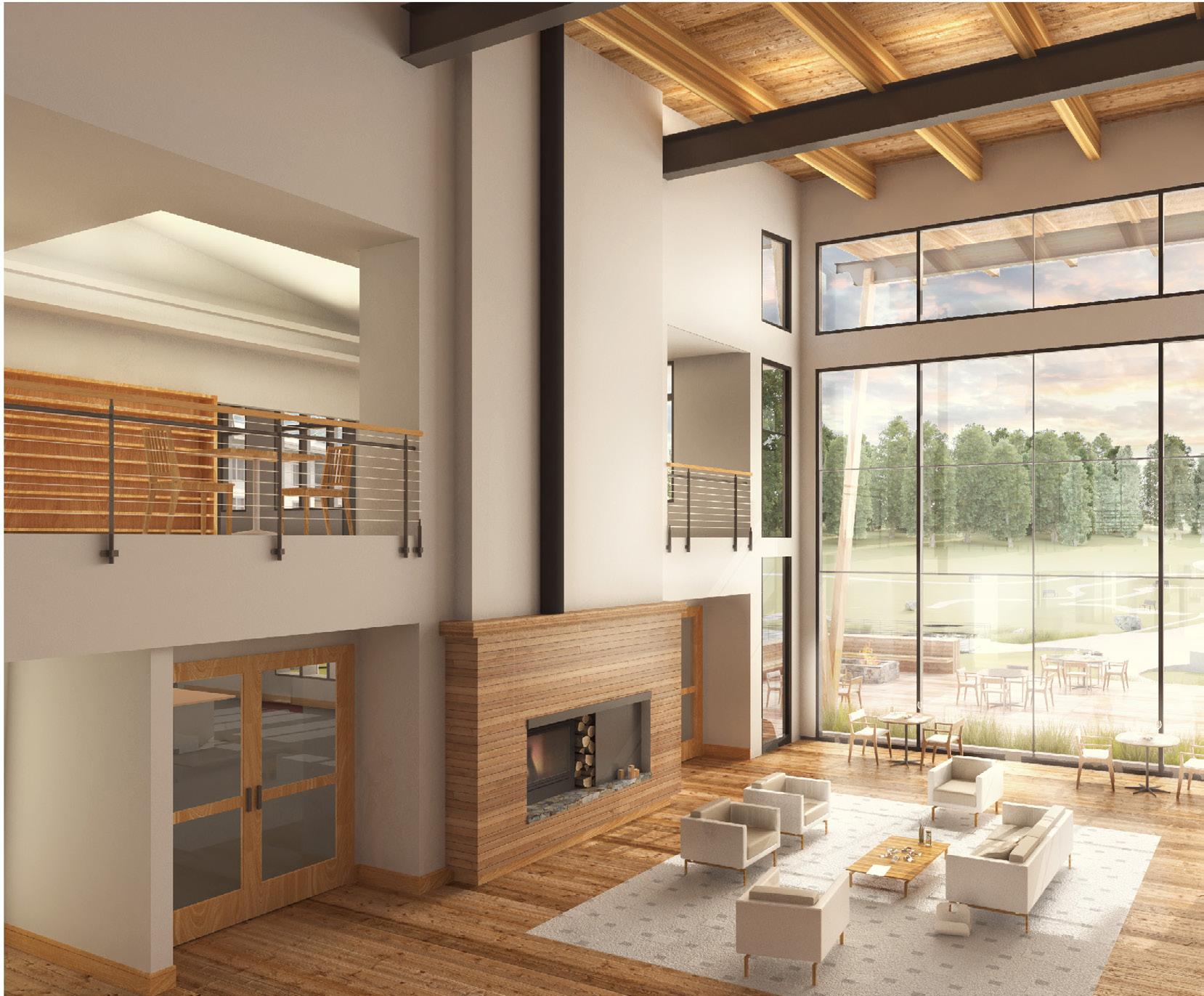
Aging With
Andy Post sits on the couch, one leg tucked under the other, shoes checked at the door to the apartment on Seattle’s Capitol Hill. He’s already put out a tray of appetizers, has checked on a vegetable curry stewing in the kitchen, and is settling a bit before dinner.
Across the room sits Tom Bigelow, comfortable in a lounge chair, below a portrait of himself painted when he was a young man. Andy is 26. Tom is 86. Certainly you’d earn a “good guess” if you suspected grandson and grandfather. But no. Caregiver and client? No, not really. What? Friends. Simply that, and as important as that. GenFriends.
The pair are part of a pilot program launched by a group called GenPRIDE, a Seattle-based LGBTQ organization aimed with laser focus at older members of that community. Founded, officially, in 2017, GenPRIDE offers an array of programs, connections, and events for elders, recognized by many as the one group—growing rapidly—ignored in some cases and certainly isolated in many respects from what might be considered mainstream and much younger LGBTQ people, to say nothing of the older, general population. And GenFriends? One of GenPRIDE’s efforts. It’s a concerted move to match young LGBTQ members with their elders. Tom, known as Father Tom, preaches at St. Clement’s Episcopal Church in Seattle’s Mount Baker neighborhood. Andy works in resource development for Solid Ground, a Seattle nonprofit. They’ve been friends since they first met in
GenPRIDE Brings Needed Connection and Programs to LGBTQ Elders BY TERRY TAZIOLI
2018; Andy is at Tom’s every week, fixing dinner. Sometimes friends eat with them. They will head to events together. Exactly what GenPRIDE had in mind. Friendship.
GenFriends, however, is but one of a myriad programs, events, and help that GenPRIDE offers and plans to expand in the future, according to genprideseattle.org.
The organization is on a mission—in a nutshell of its own words, to empower older LGBTQ adults to live with pride and dignity through programs and services that enhance belonging and support, eliminate discrimination, and honor the lives of older members.
A 2015 study by Aging with Pride at the University of Washington found that older LGBTQ adults “are at heightened risk of disability, poor health, mental distress, and living alone, compared to heterosexuals of similar age. LGBTQ older adults have been historically invisible and largely overlooked in aging and health and human services, policy, and research.” At that time of the study, the LGBTQ population represented about 2.4% of the older adult population in Seattle/King County. Their numbers are expected to double by 2030.
Successes? Absolutely. For years, GenPRIDE worked with eight other LGBTQ organizations and Capitol Hill Housing to finally win a City-of-Seattle OK to build an eight-story housing complex on Broadway aimed at older, low-income LGBTQ adults. The community is expected to open in 2023.
Steven Knipp, executive director of GenPRIDE since 2018, says they have trained hundreds of people at local organizations on issues specific to LGBTQ adults. “We teach them why LGBTQ seniors come to their doors a little bit skittish and what you can do to make your facility more welcoming,” Knipp says
Thanks to a $1.4 million grant from King County, GenPRIDE is assessing area senior centers, what they’re doing (or not) for LGBTQ elders and what GenPRIDE can do to help. And that has led to another pilot program, facilitated gatherings at Ballard and Shoreline senior centers.
“Our goal is to create a core program at all of the centers, community conversations,” Knipp says. “Once we get done with this, we’ll have senior centers equipped to handle older LGBTQ adults who come into the door.”
Glenda West is a facilitator at Ballard. She’d already been involved with senior centers before she began volunteering with GenPRIDE about a year ago.
The Ballard group has a core of regulars who show up for GenPRIDE’s community conversation. (Both West and Knipp acknowledge that Ballard had a head start, which probably helped attendance. The senior center already hosts a group called Aging Ballard Lesbian Exchange, a club organized to support older lesbians in that area.) The GenPRIDE group meets monthly, with hors d’oeuvres and wine, and topics, ranging from chosen families and

community to fear-of-aging and good reads.
It’s a strong start, and a reconnection of sorts for many LGBTQ adults who forged their early relationships in a common struggle for their rights. Now they have found less need for the fight, in part because of a growing acceptance of the LGBTQ community by many segments of the general population. As a result, many have lost contacts and connections.
West sees it this way: “If you looked at anything that was at one point segregated, you’re going to have the ‘yes, this is great that it’s mainstreamed.’ But what people don’t talk about is grieving the loss of the special separate parties, whatever that you had that were all your own. When you mainstream anything, that falls away. That sense of community, that unity goes away and you lose those bonds that once existed.” And that, she says, is what re-creating community is all about.
It’s been tougher at Shoreline, says Jessi Harris, a facilitator there.
The word about LGBTQ community conversations went out last year. A gathering was scheduled. And nobody showed up. No one showed up at the next one either. Or the one after that.
Finally, recently, three people have shown interest.
So far, that’s it, and even that in fits and starts. One enthusiastic attendee came once and has not returned. Another is excited to attend but she wants the group to grow. So does Harris, “but we
Rendering of an eight-story housing complex planned to open in 2023 on Capital Hill.

can’t make it bigger until people show up.”
Isolation is one problem, Harris says, there simply may not be a great number of older LGBTQ living in the area. “Shoreline has been described to me as an older community of conservative people, and a lot of LGBTQ people raised there went elsewhere to live. And they haven’t gone back.” Still, Harris says, there’s no giving up. “We can’t let this [the Gen.PRIDE community conversations at Shoreline] die. I won’t let it die. I’m stubborn that way.” There is a similar thread that, subtly or not, runs through practically every conversation about GenPRIDE. It will not go away. It will not die. Because it’s needed, and it’s thriving. You need only to sit and listen to Father Tom and Andy to understand what’s at work here. What’s at stake.
Father Tom: “You don’t experience another human being for any length of time that they don’t become part of you. I will be saying things the way Andy is saying things. Part of him has rubbed off on me. His wisdom. I am better off because of it.”
Andy: “The perseverance in relationships, difficult conversations. It’s a different lens here [at Father Tom’s]. A very comfortable place to be. We’ve shared a lot of our own stories. One of the things that will be nice about this friendship is that so much of it I’ll carry with me. Most of the learning will happen after the fact.”
Steven Knipp most likely would tell you this is true in everything GenPRIDE does.
Terry Tazioli works part time at University Book Store in Seattle. He left The Seattle Times in 2008, and since then has been serving in various volunteer positions, hosted a national PBS book show called WellREAD, and writes occasional freelance articles for various publications.

MONITORING GREAT LOW PRICE


PER MONTH
Monitored by ADT ® the #1 home security company in the U.S.

$ 850 VALUE
ADT ®
24/7 Monitored Home Security
24/7 monitoring provides peace of mind Yard sign and window decals help deter crime Quickly connect to fire and emergency response May qualify for a homeowners insurance discount
LIMITED TIME OFFER—CALL TODAY! 1-844-915-2566
FREE HOME SECURITY SYSTEM New customers only. Early termination fee applies. $99 installation with 36 month monitoring agreement. See all offer details below. $850 VALUE!
FREE 7 WIRELESS DOOR/ WINDOW SENSORS —enough to help protect virtually every entrance to your home. $695 VALUE!
FREE $100 VISA ® GIFT CARD from Protect Your Home!
FREE
WIRELESS REMOTE CONTROL with panic button. $139 VALUE!
Ask about same-day installation! Reply By April 15, 2020
FREE DOORBELL CAMERA When you upgrade to ADT Pulse® + Video $299 VALUE!
See all offer details below.
GIFT CARD: $100 Visa Gift Card fulfilled by Protect Your Home through third-party provider, Mpell, upon installation of a security system and execution of monitoring contract. $4.95 shipping and handling fee, gift cards can take up to 8 weeks to arrive after following the Mpell redemption process. BASIC SYSTEM: $99 Installation. 36-Month Monitoring Agreement required at $27.99 per month ($1,007.64). 24-Month Monitoring Agreement required at $27.99 per month ($671.76) for California. Offer applies to homeowners only. Basic system requires landline phone. Offer valid for new ADT Authorized Premier Provider customers only and not on purchases from ADT LLC. Cannot be combined with any other offer. The $27.99 Offer does not include Quality Service Plan (QSP), ADT’s Extended Limited Warranty. ADT Pulse: ADT Pulse Interactive Solutions Services (“ADT Pulse”), which help you manage your home environment and family lifestyle, require the purchase and/or activation of an ADT alarm system with monitored burglary service and a compatible computer, cell phone or PDA with Internet and email access. These ADT Pulse services do not cover the operation or maintenance of any household equipment/systems that are connected to the ADT Pulse equipment. All ADT Pulse services are not available with the various levels of ADT Pulse. All ADT Pulse services may not be available in all geographic areas. You may be required to pay additional charges to purchase equipment required to utilize the ADT Pulse features you desire. ADT PULSE + VIDEO: ADT Pulse + Video installation is an additional $299. 36-month monitoring contract required from ADT Pulse + Video: $59.99 per month, ($2,159.64), including Quality Service Plan (QSP). Doorbell camera may not be available in all areas. GENERAL: For all offers, the form of payment must be by credit card or electronic charge to your checking or savings account, satisfactory credit history is required and termination fee applies. Certain packages require approved landline phone. Local permit fees may be required. Certain restrictions may apply. Additional monitoring fees required for some services. For example, Burglary, Fire, Carbon Monoxide and Emergency Alert monitoring requires purchase and/or activation of an ADT security system with monitored Burglary, Fire, Carbon Monoxide and Emergency Alert devices and are an additional charge. Additional equipment may be purchased for an additional charge. Additional charges may apply in areas that require guard response service for municipal alarm verification. Prices subject to change. Prices may vary by market. Some insurance companies offer discounts on Homeowner’s Insurance. Please consult your insurance company. Photos are for illustrative purposes only and may not reflect the exact product/service actually provided. Licenses: AL-19-001104, AR-CMPY.0001725 AZ-ROC217517, CA-ACO6320, CT-ELC.0193944-L5, DC-EMS902653, DC-602516000016, DE-07-212, FL-EC13003427, EC13003401, GA-LVA205395, IA-AS-0206, ID-ELE-SJ-39131, IL-127.001042, IN-C.P.D. Reg. No. – 19-08088, City of Indianapolis: LAC-000156, KY-City of Louisville: 483, LA-F1914, LA-F1915, LA-F1082, MA-1355C, MD-107-1626, ME-LM50017382, MI-3601205773, MN-TS01807, MO-City of St. Louis: CC#354, St. Louis County: 95091, MS-15007958, MT-PSP-ELS-LIC-247, NC-25310-SP-FA/LV, NC-1622-CSA, NE-14451, NJ Burglar Alarm Lic. # -NJ-34BF00021800, NM-353366, NV-0068518, City of Las Vegas: 3000008296, NY-Licensed by the N.Y.S. Department of State UID#12000317691, NYS #12000286451, OH-53891446, City of Cincinnati: AC86, OK-AC1048, OR-170997, Pennsylvania Home Improvement Contractor Registration Number: PA022999, RI-3582, RI-7508, SC-BAC5630, SD- 1025-7001-ET, TN-1520, TX-B13734, ACR-3492, UT-6422596-6501, VA-115120, VT-ES-2382(7C), WA-602588694/ECPROTEYH934RS, WI-City of Milwaukee: PAS-0002790, WV-WV042433, WY-LV-G-21499. 3750 Priority Way South Dr. Indianapolis, IN 46240 ©2017 DEFENDERS, Inc. dba Protect Your Home DF-CD-NP-Q120
Go for It!
Robert Frost once wrote, “The afternoon knows what the morning never suspected.” Despite building skills over the course of our lives, many of us don’t realize our true calling until we hit our later years. Gifted with perspective and clarity about what we value, we can finally give ourselves permission to abandon what’s been holding us back and try on new roles. The research on aging confirms that a late life reboot is a good move. Older adults live longer when we feel worthy and happy; when we think of our lives and skillsets as improving instead of stagnating. So, what does a third act reinvention look like? For these six Puget Sounders it’s about taking risks, doubling down, and reaching deep to find happiness. It’s never too late to find your passion and act on it BY ANN RANDALL PHOTOS BY ERNIE SAPIRO
As a child, Hein’s mother told her she danced while in the womb and signed her up for ballet classes. For a free spirit who preferred twirling and leaping, staid ballet wasn’t a good fit. At ten, her grandmother gave her Spanish castanets, a prescient gift she used for childhood freeform choreography. In college Hein discovered African dance. In later years, she joined folk dancing groups and fantasized ice skating a routine to the music of Santana.
Eventually, her love of dance took a backseat to a demanding career, moves, home renovations, and marriage. But two years before retirement, Hein noticed a beginning flamenco class that was scheduled nearby and on her one free evening. Recalling her gifted castanets and attracted by the dance’s passionate, exotic Lora Hein Dances Like She Means It
Ed Cuomo
Elayne Vogel
Keith Johnson
Jan Johnson
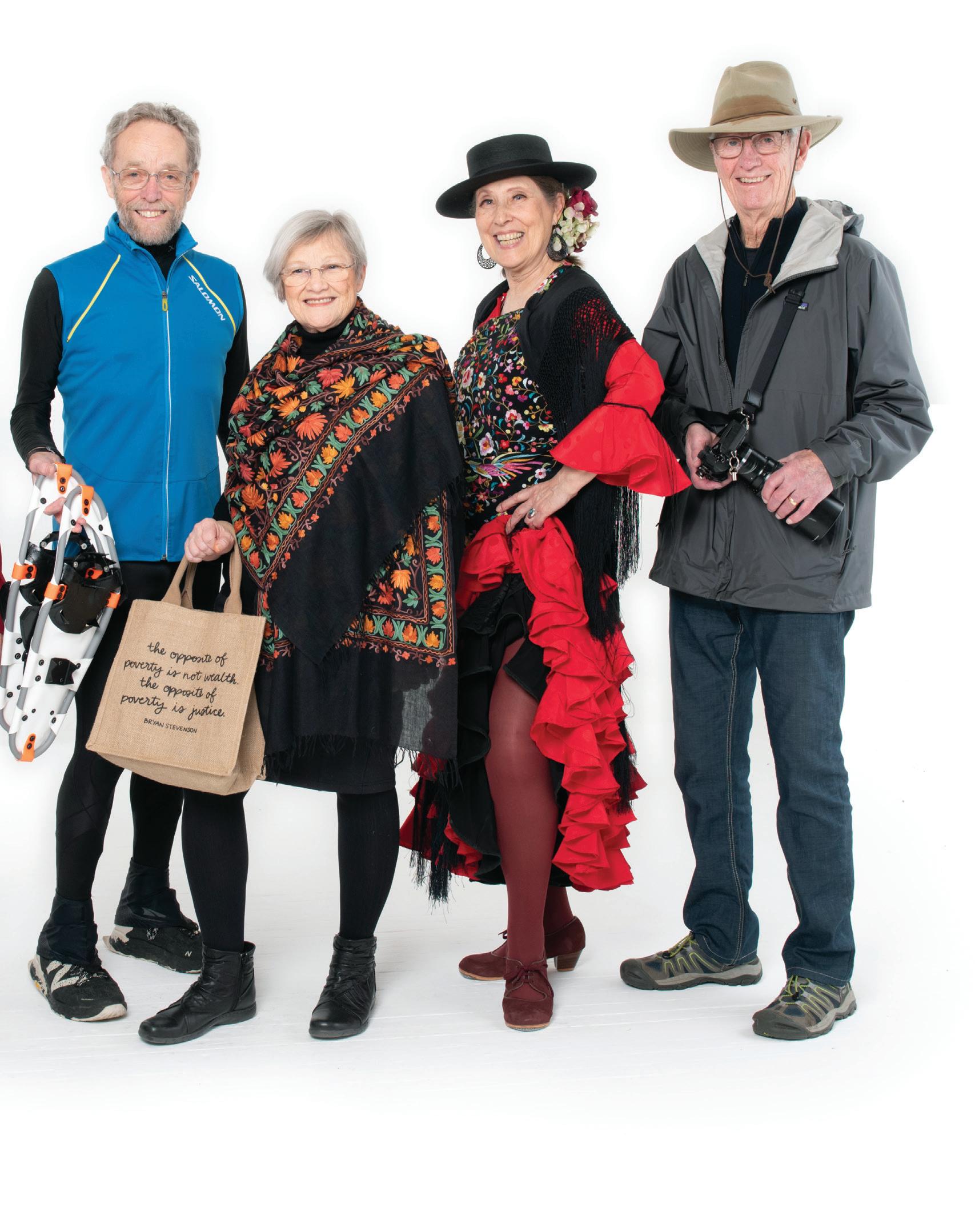
Lora Hein
Don Russell

allure, she decided to give it a try. After the first class she was hooked. She told her teacher she could think of no better way to dementia proof her brain than to immerse herself in learning flamenco’s intricate movements. She loved the drama of it—the swirling skirts, the clattering heels, the dramatic arm postures, and the joy she felt dancing again.
With more time to practice post-retirement, Heim signed up for intermediate lessons, performing with her class at Northwest Folklife Festival. It was nerve-wracking and thrilling to dance in front of a Seattle Center packed auditorium. It was supposed to be a one-time public performance. Then, a few years later, came an enticing call. Would she be willing to dance in a 2018 flamenco showcase to a medley of Santana tunes? It was kismet. “Black Magic Woman” was not only the soundtrack of an old skating fantasy, it became the beloved soundtrack of her flamenco onstage encore.
Keith, a retired teacher, is no slouch when it comes to embracing new roles. He and his wife Jan are enthusiastic cheerleaders for each other’s third act do-over. He supports her efforts by volunteering as a driver for KIAC and helping out whenever he’s not training and competing as a world-class senior athlete.
A competitive tennis player since high school, Johnson has over five decades of tennis tournaments behind him. At 65, he and his partner won the Washington State Doubles Championship in their age group. But not satisfied with that performance, he went in search of an outdoor activity that would help him stay fit in the winter and discovered the lesser known sport of snowshoe running.
A cold weather endurance workout that burns more calories than road running and is twice as difficult, competitive snowshoe running is a 200-year-old European sporting event that’s only recently gained popularity in the United States. Now age 73, Johnson has competed in seven national snowshoe championships held in such high-altitude locations as the 10,000-foot Colorado Rockies. Despite taking up the sport later in life, he’s good enough that he’s won several bronze, silver, and gold individual medals.
He’s so good that last year Johnson qualified for the 2019 USA World Cup Snowshoe Team. Competing in Italy’s Tyrolian Alps, he took eighth place in his division. He qualified for Team USA again this year, and accompanied by his wife Jan as cheerleader, took the bronze medal in February’s World Cup competition at Mt. Myoko, Japan. Keith Johnson Goes for the gold
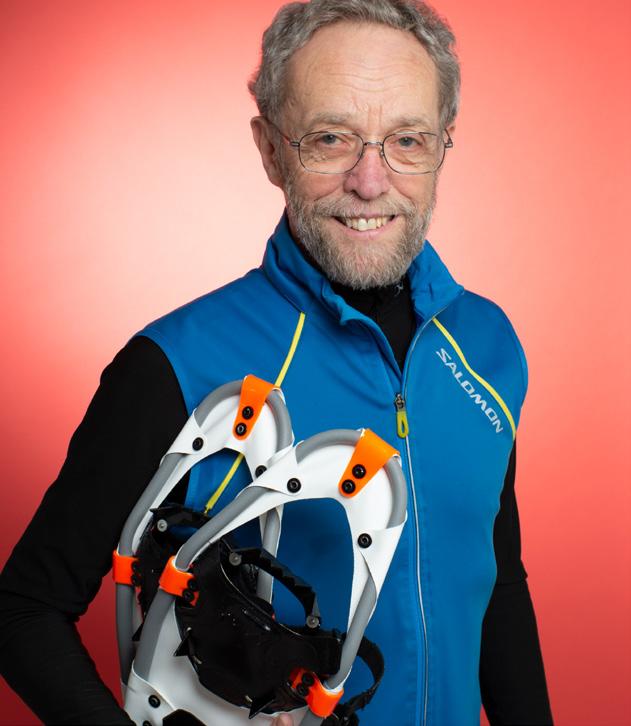
For 74-year-old Jan Johnson a lifetime of activism took on new urgency the morning of November 10, 2016. The retired school librarian and long-time political volunteer felt a sense of dread. Anti-immigrant rhetoric of the presidential campaign was impacting her community. She had neighbors who were fearful. She heard from former teaching colleagues their students were scared. So, she contacted Kitsap Immigration Assistance Center (KIAC) and volunteered to do whatever they needed. As the only regional nonprofit providing legal and family support services to low- and moderate-income immigrants, KIAC needed a lot, but what they needed most, they told Johnson, was legal assistance for their clients.
Two months later, Johnson boarded a plane for the Washington, D.C. Women’s March carrying a tote of study materials for an exam that would certify her as a Department of Justice Accredited Legal Representative. By June she’d completed the rigorous course and began providing legal representation to KIAC clients. The nonprofit provides a variety of services including immigration court representation and asylum and removal defense, but Johnson’s passion is making new citizens. She regularly puts in 40-hour workweeks navigating hopeful residents through the complex and evolving requirements to become naturalized; work that includes tutoring them for their civics exam, assisting with citizenship documents, and travelling to U.S. Citizenship and Immigration offices throughout the state to represent them in naturalization hearings. Since that ominous November morning, over 100 citizen applicants from 18 different countries have benefitted from her inspired efforts. Jan Johnson Uses Her Voice to Give Voice to Others
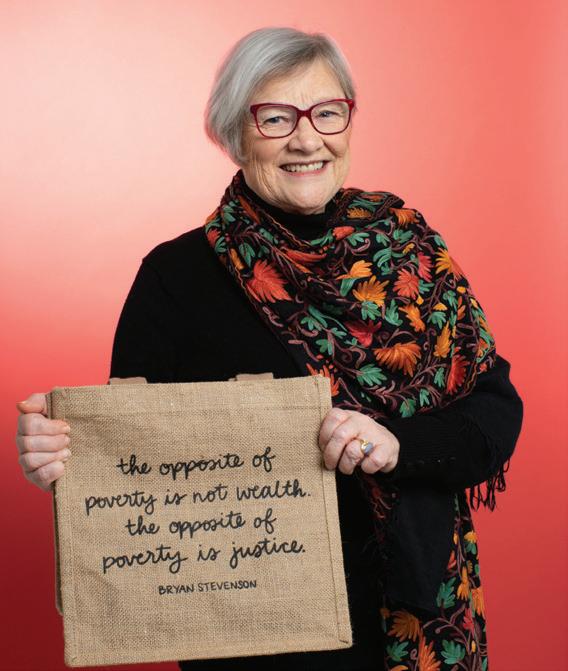
Elayne is 79. Ed is 70. And while they each have a fascinating backstory (she’s a respected Tacoma artist working in multiple mediums and his family immigrated from the Netherlands when he was young) this is a story about taking a risk for late in life love. Elayne grew up in the Jewish faith and, as was expected by family and religious tradition, at age 20, married a Jewish man. That marriage ended in divorce. Deciding love was more important than a common faith, she fell in love and tried again. That marriage also ended in divorce. So, four years ago at age 75, when she signed up for an online dating site, it was with a healthy dose of skepticism. She planned to date, but never again live with someone.
Enter Ed. Also divorced, Ed describes his online dating experience as frustrating, confusing, and disappointing at times. His divorce, six years before he met Elayne, was painful. Still, when they agreed to meet for coffee on the first date, they found they had a lot in common. Elayne is a prolific artist and former 25-year tenured faculty member at Green River Community College. Ed is a graphic designer who worked for advertising agencies and now runs his own design studio. They both love photography. It was tentative at first. After the coffee date, there was a movie date. For three years they only saw each other on weekends. Then more regularly. They traveled together. Had fun adventures as a couple. Elayne realized she’d never been in a relationship so compatible: one where she felt loved, comfortable, and loving. One where she was appreciated for her independence. It became apparent to Ed that he couldn’t imagine being with anyone else. This past December the couple moved in together. “We finally realized,” explained Ed, “we were a bonded couple meant for each other.” Elayne Vogel & Ed Cuomo Find New Love and Commitment

Ann Randall is an independent traveler and writer who loves venturing to out-ofthe-way locales from Azerbaijan to Zimbabwe. A former educator, she now observes international elections and does volunteer work in India. Her articles have appeared in online and print publications, and she blogs at PeregrineWoman.com.
This September, 83-year-old Don Russell will be hiking through the Alaskan wilderness in search of grizzly bears to photograph. An avid boater and outdoorsman in earlier years, Russell had always taken photos of mountains and waterways to record trips. Eight years ago, after he retired, his wife convinced him to join her Woodland Park walking group. He did, albeit reluctantly, and brought his camera along for company. It was a fortuitous decision.
On the walks, he discovered he loved photographing animals. They were a challenge. They moved. They were unpredictable, even in a zoo. Russell wondered what they’d be like in their natural environment and decided to find out by joining the Northwest Nature and Wildlife Photography Club, upgrading his equipment and travelling to photograph animals in the wild.
His 80th birthday was spent with his photography club in the rainforest islands of Hartley Bay, British Columbia photographing the elusive Spirit Bear and attending a First Nations celebration. A year later, he traveled to Rwanda to photograph mountain gorillas, and then to Tanzania to shoot wildlife photos in the Ngorongoro and Serengeti National Parks. At age 82 he flew to Brazil to the world’s largest wetland, home to the biggest predator in the tropical Americas—the jaguar. That year he also traveled the rough roads of south-central India to capture Royal Bengal Tigers on film.
Russell used his seventh decade to follow an unexpected curiosity, expand a travel bucket list and learn new skills. In the process he became something new—a bona fide wildlife photographer. Don Russell Takes a Walk on the Wild Side


Absent real limitations of health and mobility, you are only limited by your imagination. Your age has nothing to do with it. So, go for it!









